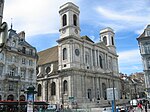Besançon (UK: , US: , French: [bəzɑ̃sɔ̃] , Franco-Provençal: [bəzɑ̃ˈsɔ̃]; archaic German: Bisanz; Latin: Vesontio) is the prefecture of the department of Doubs in the region of Bourgogne-Franche-Comté. The city is located in Eastern France, close to the Jura Mountains and the border with Switzerland.
Capital of the historic and cultural region of Franche-Comté, Besançon is home to the Bourgogne-Franche-Comté regional council headquarters, and is an important administrative centre in the region. It is also the seat of one of the fifteen French ecclesiastical provinces and one of the two divisions of the French Army.
In 2020 the city had a population of 118,258, in a metropolitan area of 281,610, the second in the region in terms of population.
Established in a meander of the river Doubs, the city was already important during the Gallo-Roman era under the name of Vesontio, capital of the Sequani. Its geography and specific history turned it into a military stronghold, a garrison city, a political centre, and a religious capital.
Besançon is the historical capital of watchmaking in France. This has led it to become a centre for innovative companies in the fields of microtechnology, micromechanics, and biomedical engineering. The University of Franche-Comté, founded in 1423, enrolls nearly 30,000 students each year, including around 4,000 trainees from all over the world within its Centre for Applied Linguistics (CLA).
The greenest city in France, it enjoys a quality of life recognized in Europe. Thanks to its rich historical and cultural heritage and its unique architecture, Besançon has been labeled a "Town of Art and History" since 1986. Its fortifications, designed by Vauban, have been listed as a UNESCO World Heritage Site since 2008.







